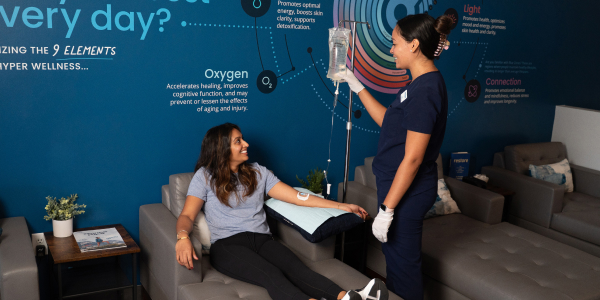Ongoing stress is a widespread issue that can take a significant toll on both mental and physical well-being. It disrupts the body’s neuroendocrine balance, elevates cortisol and interferes with natural sleep-wake cycles.¹
In turn, inadequate sleep impairs emotional regulation, increases pain sensitivity and weakens immune resilience, creating a feedback loop that reinforces stress.² To effectively address both stress and sleep, integrative wellness strategies must target systemic inflammation, oxidative stress and autonomic imbalance. Three modalities with growing scientific support offer therapeutic solutions to break this cycle.³
The Biological Toll of Stress & Sleep Disruption
When the body remains in a prolonged stress state, the hypothalamic-pituitary-adrenal (HPA) axis can become dysregulated, often resulting in altered cortisol patterns, such as sustained elevation or impaired regulation. This suppresses melatonin production, disrupts circadian rhythms, and compromises the brain’s ability to enter deep, restorative sleep stages.⁴ Quality sleep is essential for glymphatic clearance, memory consolidation, emotional processing and cellular repair. Conversely, poor sleep exacerbates systemic inflammation, cognitive fatigue and emotional reactivity, perpetuating a cycle that becomes increasingly difficult to disrupt without targeted interventions.⁶
1. Mild Hyperbaric Oxygen Therapy
Mechanism of Action:
Mild Hyperbaric Oxygen Therapy (mHbOT) involves breathing oxygen-enriched air inside a pressurized chamber at around 1.3 ATA. This enhanced oxygenation effect helps elevate plasma oxygen levels, allowing for increased diffusion into hypoxic tissues and mitochondrial compartments that are typically underserved by standard circulation.⁷
Clinical Insights:
- Improved mitochondrial function: Studies have shown that enhanced oxygenation helps elevate ATP and NAD⁺ levels in the brain, both of which are essential for cellular resilience and neuroprotection.⁸
- Reduction in oxidative stress: Peer-reviewed research demonstrates a measurable decrease in reactive oxygen metabolites and inflammatory cytokines following oxygenation treatment.⁹
- Enhanced neurocognitive and emotional regulation: Functional imaging studies suggest improved activity from enhanced oxygenation in prefrontal and limbic regions associated with mood, memory and executive function.¹⁰
Wellness Outcomes:
- Enhanced parasympathetic activation and relaxation
- Deeper, uninterrupted sleep cycles
- Improved mood stability and mental clarity
mHbOT serves as a foundational therapy for individuals experiencing chronic stress, fatigue or sleep disturbances. Regular sessions are associated with cumulative benefits over time, particularly when integrated into a broader wellness protocol.
2. Compression
Mechanism of Action:
Compression utilizes dynamic pneumatic pressure to stimulate blood flow, enhance venous return and facilitate lymphatic drainage. The therapy is commonly used by athletes to accelerate muscular recovery, but its physiological effects extend into stress and sleep health.
Scientific Basis:
- Healthy blood flow enhances the transport of oxygen and vital nutrients to cells while helping the body flush out metabolic byproducts more efficiently.
- Decreased muscle tension can reduce somatic symptoms of stress, such as jaw clenching, tight shoulders and restlessness, conditions often linked to sleep disruption.
- Stimulation of the lymphatic system to help move waste and reduce systemic inflammation that impairs rest and recovery.
Wellness Outcomes:
- Reduced physical tension and soreness
- Enhanced relaxation response via mechanical stimulation
- Improved sleep onset and ability to sustain sleep
When integrated post-exercise or as part of an evening wind-down routine, Compression can be a valuable ally in promoting physical and mental restoration.
3. Infrared Sauna
Mechanism of Action:
Infrared Saunas utilize infrared wavelengths to penetrate tissue layers directly, inducing thermogenesis without overwhelming the cardiovascular or respiratory systems. Infrared light warms the body directly rather than heating the surrounding air, allowing for a more comfortable environment while delivering heat deep into tissues for greater physiological benefit.
Research-Backed Effects:
- Infrared exposure has been shown to reduce serum cortisol, while concurrently increasing endorphins and brain-derived neurotrophic factor (BDNF)—a key player in mood stabilization and neurogenesis.
- Consistent use helps optimize blood vessel function and boosts nitric oxide levels, promoting cardiovascular health and aiding sleep by supporting the body’s natural temperature regulation.
- Studies also show improvements in heart rate variability (HRV), a biomarker for autonomic nervous system balance and stress recovery.
Wellness Outcomes:
- Deepened relaxation and improved autonomic nervous system balance
- Reduced inflammatory markers associated with sleep disturbances
- Facilitated transition into sleep via core temperature modulation
Infrared Sauna sessions, particularly in the late afternoon or early evening, can prime the body for sleep by inducing a natural cooldown period that mirrors the circadian drop in core body temperature.
Get the Quality Sleep Your Body Deserves
Stress and sleep are deeply interconnected. Addressing one without the other is rarely effective in the long term. Mild Hyperbaric Oxygen Therapy, Compression and Infrared Sauna offer distinct, scientifically supported mechanisms to disrupt the stress-sleep feedback loop. By enhancing cellular oxygenation, promoting circulatory efficiency and rebalancing the autonomic nervous system, these therapies create the internal environment necessary for deep, restorative sleep and lasting stress resilience.
For those seeking measurable improvements in energy, cognition and emotional well-being, integrating these wellness tools into a consistent routine can deliver transformative results over time.
Medical services are provided by an independently-owned physician practice. Some services may require medical clearance and a prescription. We reserve the right to refuse service to anyone. Services, therapies, nutrients and prices may vary per location. The content on our site, blog posts, educational materials, app, promotional newsletters, and any other written content are not intended to replace an evaluation with a qualified healthcare professional and are not intended as medical advice.






